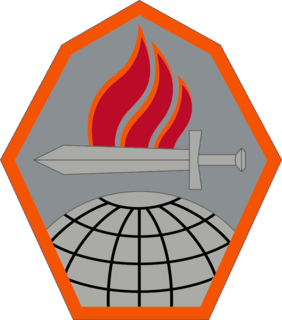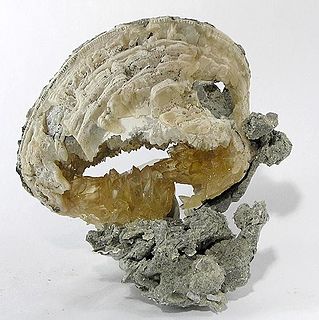
The Dalles is the county seat and largest city of Wasco County, Oregon, United States. The population was 13,620 at the 2010 census, and is the largest city on the Oregon side along the Columbia River outside the Portland Metropolitan area.

The United States Army Pacific (USARPAC) is an Army Service Component Command (ASCC) of the United States Army and is the army component unit of the United States Indo-Pacific Command. The main areas that this command has jurisdiction in include Hawaii, Alaska, the Pacific Ocean, South Korea and Japan. It also performs missions in Southeast Asia, in the countries such as the Philippines and Bangladesh. The United States Eighth Army in Korea has operational command and control on US Forces in Korea since January 2012, and USARPAC headquarters became its Army Component Command at the same date.
Henry Atkinson was a United States army officer. He was a native of Person County, North Carolina.

Fort Gordon, formerly known as Camp Gordon, is a United States Army installation established in October 1941. It is the current home of the United States Army Signal Corps, United States Army Cyber Corps, and Cyber Center of Excellence. It was once the home of The Provost Marshal General School and Civil Affairs School. The fort is located slightly southeast of Grovetown, Georgia and southwest of the city Augusta, Georgia. The main component of the post is the Advanced Individual Training for Signal Corps military occupational specialties. In 1966–68 the Army's Signal Officer Candidate School graduated over 2,200 Signal officers. Signals Intelligence has become more visible and comprises more and more of the fort's duties.
The Cayuse War was an armed conflict that took place in the Northwestern United States from 1847 to 1855 between the Cayuse people of the region and the United States Government and local American settlers. Caused in part by the influx of disease and settlers to the region, the immediate start of the conflict occurred in 1847 when the Whitman Massacre took place at the Whitman Mission near present day Walla Walla, Washington when fourteen people were killed in and around the mission. Over the next few years the Provisional Government of Oregon and later the United States Army battled the Indians east of the Cascades. This was the first of several wars between the Indians and American settlers in that region that would lead to the negotiations between the United States and Indians of the Columbia Plateau, creating a number of Indian reservations.

Fort Tejon in California is a former United States Army outpost which was intermittently active from June 24, 1854, until September 11, 1864. It is located in the Grapevine Canyon between the San Emigdio Mountains and Tehachapi Mountains. It is in the area of Tejon Pass along Interstate 5 in Kern County, California, the main route through the mountain ranges separating the Central Valley from the Los Angeles Basin and Southern California. The fort's location protected the San Joaquin Valley from the south and west.
The Department of the Pacific or Pacific Department was a major command (Department) of the United States Army during the 19th century.

The First Regiment Oregon volunteer Cavalry was a volunteer regiment in United States service Union army that was formed in response to the American Civil War. With men recruited in Oregon and some recruited in surrounding states, the regiment primarily served to protect the state of Oregon and surrounding territories during the American Civil War.
Camp Drum refers to three US military facilities:

Fort Simcoe was a United States Army fort erected in south-central Washington Territory to house troops sent to keep watch over local Indian tribes. The site and remaining buildings are preserved as Fort Simcoe State Park, located eight miles (13 km) west of modern White Swan, Washington, in the foothills of the Cascade Mountains.

The 4th California Infantry was a volunteer infantry regiment recruited from northern California during the American Civil War. It was organized at Sacramento, Placerville, and Auburn in September and October 1861.

The 2nd Regiment California Volunteer Infantry was an infantry regiment in the Union Army during the American Civil War. It spent its entire term of service in the western United States. Organized at San Francisco and Carson City September 2, 1861, to December 30, 1862, and attached to Department of the Pacific. The regiment was first assembled at the Presidio, San Francisco, and after completing its organization, five companies were sent to Oregon and Washington Territory, to relieve the regular troops, and two companies were sent to Santa Barbara. The troops of this regiment sent to Oregon were afterwards returned to California. It was mustered out during the month of October, 1864.

Henry M. Black was a United States Army officer who served as Commandant of Cadets at the United States Military Academy.

The Department of Oregon was one of two Army Departments created September 13, 1858, replacing the original Department of the Pacific and was composed of the Territories of Washington and Oregon, except the Rogue River and Umpqua Districts, which were assigned to the Department of California. Its creation was authorized by General Orders, No. 10, of the United States Department of War, Adjutant-General's Office, September 13, 1858. Its Headquarters was at Fort Vancouver, in the Washington Territory.
The Dalles Military Road, also known as The Dalles – Boise Military Wagon Road, was a mid-19th century wagon road surveyed and barely built by The Dalles Military Road Company between 1868 and 1870. To qualify for government land grants, the company was supposed to build a wagon road from The Dalles, Oregon, to Fort Boise in Idaho. However, the company's road, on which it spent about $6,000 and for which it received nearly 890 square miles (2,300 km2) of public land, consisted largely of existing wagon roads and rudimentary trails. In particular, the company took credit for building a well-traveled and pre-existing wagon road between The Dalles and Canyon City, Oregon.

Fort Sumner was a coastal defense fortification on Munjoy Hill in Portland, Maine, United States. It was built in 1794 as part of the First System of coastal fortifications built by the United States. It was reportedly originally named Fort Allen after the nearby Revolutionary War battery that probably became part of Fort Sumner, but was renamed in 1797 after Increase Sumner, the incumbent Governor of Massachusetts, of which Maine was then a part. The location is now Fort Sumner Park, also called Standpipe Park, at 60 North Street.













